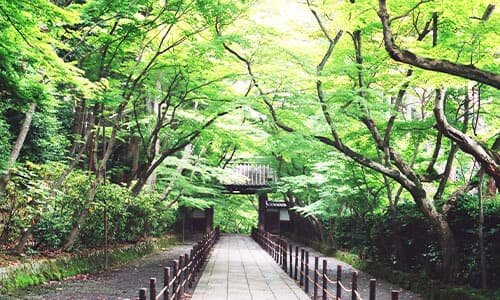- Culture
- Kyoto
Komyo-ji Temple
(Main temple of the Seizan Jodoshu Sect)

Komyo-ji, one of the top temples famous for its beautiful fall colors
Komyo-ji in Nagaokakyo City in Kyoto Prefecture stands on grounds that cover a vast area of 66,000 square meters with hundreds of maple trees. It is the main temple of the Seizan Branch of the Jodo Sect, where Honen (the founder of the Jodo Sect) read the Nembutsu chant for the first time in Japan. The main feature of this temple in late fall is the photogenic 200-meter-long Momiji Approach, which offers a spectacular view of vivid red color. Once you step on the approach that is completely covered with fallen foliage, you will feel like you are walking on a red carpet surrounded by an awe-inspiring and refined atmosphere.

Yanagidani Kannon Yokoku-ji Temple, a haven of hydrangeas and maple trees
Nagaokakyo City boasts a great number of temples with beautiful features, and one of the best examples is Yokoku-ji Temple. Locals have always paid a great amount of respect as a spot for praying for relief from eye diseases. The temple also attracts numerous visitors with its spectacle of approximately 5,000 hydrangeas in summer and colorful maple leaves in fall. One of the main features is the garden, which appears as stunning as a painting when viewed from the Kamisho-in Hall, open to the public on the 17th of every month. The landscaping was highly praised by the noted gardener Shigemori Mirei, who created a number of gardens in the 1900s, including the famous one in Tofuku-ji Temple. Another attraction on the grounds are hanachozu, stone bowls and basins in which seasonal flowers are floating.

Nagaoka Tenmangu Shrine, one of the top spots for rhododendron in Kyoto
Nagaoka Tenmangu Shrine, which enshrines a god dedicated to studying, exhibits a 200-meter-long tunnel of deep red rhododendron bushes roughly 170 years old, which is said to be one of the best in Kyoto, in mid-April each year. Its garden, known as Kinkei-en, is illuminated in early April to better show off its beautiful cherry blossoms, and also in the fall to highlight the colorful seasonal foliage. It also attracts visitors over the New Year period, especially children, as it is believed that they will become smarter if they touch their heads after touching the statue of a cow, supposedly a messenger from the gods.

Otokuni-dera Temple, famous for the thousands of peonies on the grounds and its enchanting display of white umbrellas
At Otokuni-dera Temple, about 2,000 peonies of different colors come into full bloom in late April every year. They are covered by attractive white umbrellas to avoid over-exposure to the harsh sun, just like a scene from a fairy tale. Said to be established by Shotoku Taishi, a famous political figure during the 6th and 7th centuries, it is one of the oldest temples in Kyoto. It is also well known for its connection to the noble priest Kukai (or Kobo Daishi). When you visit this temple, it is recommended to buy a good luck charm embroidered with the image of a peony.
Location
| Name | Komyo-ji Temple (Main temple of the Seizan Jodoshu Sect) |
|---|---|
| Website | http://www.kyototourism.org/en/sightseeing-info/50.html |
| Address | 26⁻1 Aosaijonouchi, Nagaokakyo-shi, Kyoto |
| Access | From JR Nagaokakyo Station or Hankyu Nagaoka-tenjin Station, take Hankyu Bus (Route 22) for approximately 15 minutes and get off at Asahigaoka Home-mae. |
| Business Hours | 9:00 to 16:00 |
| Closed | Open all year round |
| Inquiries | TEL: 075-955-0002 |
| Admission | 500 yen (only during the autumn foliage season) |











